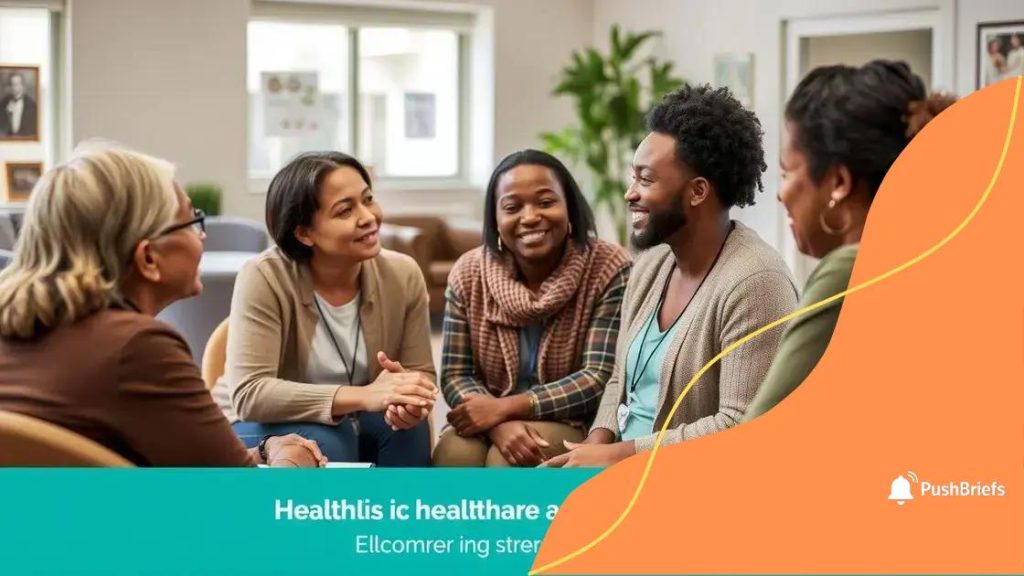Access to healthcare continues to be a primary concern

Community initiatives significantly improve healthcare access by addressing local needs through services like health fairs, mobile clinics, and partnerships with healthcare providers, fostering collaboration and enhancing the overall health of communities.
Access to healthcare continues to be a primary concern for many individuals. Have you ever thought about how it affects daily lives and health outcomes? This article delves into the factors influencing healthcare access and what can be done to enhance it.
Understanding the current landscape of healthcare access
Understanding the current landscape of healthcare access is essential for addressing the needs of communities. With numerous factors affecting accessibility, it’s crucial to recognize how they interconnect.
This landscape is shaped by elements like socioeconomic status, geographical location, and available healthcare resources.
Key Factors Influencing Healthcare Access
Several key factors significantly impact how individuals can access healthcare services. Knowing these factors helps us see the bigger picture in healthcare accessibility.
- Socioeconomic Status: People with higher income levels often have better access to healthcare.
- Insurance Coverage: Those without insurance may face significant barriers in receiving necessary care.
- Geographical Barriers: Rural areas often have limited healthcare facilities compared to urban settings.
- Health Literacy: Understanding healthcare options and navigation can influence access.
Furthermore, it’s vital to acknowledge the role of policies and regulations. For example, recent reforms try to enhance healthcare access for underserved populations, aiming to create a more equitable system. These policies can make a notable difference in the lives of many.
Technology is also playing a growing role. With telemedicine on the rise, patients can often overcome traditional barriers, such as distance and transportation issues. This innovation offers a promising alternative in partiality to conventional healthcare models.
The Role of Community Support
Communities are essential in improving healthcare access. Grassroots initiatives often provide services where they are needed most. Through partnerships and outreach, communities can raise awareness about available resources and support.
Ultimately, understanding healthcare access requires a look at both systemic factors and personal circumstances. Only then can we better address the challenges faced by individuals in obtaining care. The evolving landscape presents both challenges and opportunities, reinforcing the need for continuous improvement and awareness in our health systems.
Barriers preventing access to healthcare services
Barriers preventing access to healthcare services can be complex and varied. Understanding these barriers is crucial for improving healthcare accessibility for everyone.
Common obstacles include financial constraints, lack of transportation, and insufficient availability of providers in certain areas.
Financial Barriers
The cost of healthcare is often a major hurdle. Many individuals cannot afford insurance or high out-of-pocket expenses. This situation disproportionately affects low-income families who already struggle to meet basic needs.
- High Medical Costs: Unplanned medical expenses can lead to financial strain.
- Lack of Insurance: Uninsured individuals are less likely to seek medical care.
- High Deductibles: Even with insurance, high deductibles may prevent individuals from accessing care.
Another significant barrier is the lack of transportation. In many regions, especially rural areas, public transport options may be limited or nonexistent. This lack of reliable transportation can prevent patients from attending necessary appointments or receiving timely care.
Availability of Healthcare Providers
Some communities face a shortage of healthcare providers, particularly specialists. This scarcity leads to long wait times and can discourage individuals from seeking necessary care.
Additionally, healthcare literacy also plays a role in access issues. If individuals do not understand how to navigate the healthcare system, they may forgo much-needed services. Education about available resources is vital to overcoming these barriers.
Lastly, cultural and language differences can impede access to care. Patients from diverse backgrounds may hesitate to seek services if they feel misunderstood or if language barriers exist. Ensuring cultural competency among healthcare providers is essential to breaking down these barriers and facilitating better access.
How technology is transforming healthcare accessibility

Technology is a powerful tool that is transforming healthcare accessibility. It has the potential to bridge gaps that have long existed in the healthcare system. Through various innovations, more people can access the care they need.
One significant advancement is telemedicine, which allows patients to consult with healthcare providers remotely. This can be especially beneficial for those living in rural areas where healthcare facilities may be far away.
Benefits of Telemedicine
Telemedicine offers numerous perks that make it easier for individuals to receive healthcare services. For instance:
- Convenience: Patients can have consultations from their homes, saving time and travel costs.
- Increased Access: Those in remote locations can connect with specialists that may not be available locally.
- Flexible Scheduling: Many telemedicine services offer extended hours, accommodating various work schedules.
In addition to telemedicine, mobile health apps are growing in popularity. These apps help users manage their health effectively. They can track medications, provide reminders for appointments, and even offer virtual support groups.
Mobile Health Applications
Mobile health apps enable users to take charge of their health journey. Features often include:
- Medication Management: Apps can remind patients when to take their medications.
- Health Monitoring: Users can keep track of vital signs like heart rate and blood pressure.
- Appointment Scheduling: Many apps allow easy booking of medical appointments with healthcare practitioners.
Artificial intelligence (AI) is another game-changer. AI can analyze patient data quickly and provide insights that help in diagnosis and treatment planning. It also plays a role in predictive analytics, helping healthcare systems identify potential health issues before they become serious.
Overall, technology is making strides in improving healthcare accessibility. While challenges remain, these advancements represent significant progress toward a more inclusive healthcare system for everyone.
The role of policy in healthcare access challenges
The role of policy in addressing healthcare access challenges is critical. Policies can either enhance or hinder individuals’ ability to receive necessary care. Understanding this relationship helps us see how policy changes can improve accessibility.
Various laws and regulations shape healthcare availability, impacting everything from insurance coverage to the quality of services offered.
Current Policies Impacting Healthcare Access
Several key policies play a significant role in shaping healthcare access. These include:
- Medicaid Expansion: In states that have expanded Medicaid, more low-income individuals can access healthcare services.
- The Affordable Care Act (ACA): This law has increased insurance coverage and improved protections for patients with pre-existing conditions.
- Provider Reimbursement Policies: How providers are reimbursed can affect their willingness to accept patients, especially those who are uninsured.
Poorly designed policies can lead to increased disparities, especially for vulnerable populations. For instance, lack of funding or support for rural health clinics can limit access for those in remote areas.
Impact of Legislative Changes
Legislative changes also have rapid effects on accessibility. When laws change, providers and patients must adapt quickly. This often causes confusion and can temporarily disrupt care.
Furthermore, the involvement of the community is essential to push policy changes. Advocacy groups often work tirelessly to highlight access concerns and propose solutions to improve healthcare access.
Effective communication between policymakers and communities is vital. Policymakers need to hear from those affected by access challenges to understand the real impact of their decisions.
Ultimately, policy plays a huge role in determining who has access to healthcare. By advocating for better policies, we can help ensure that everyone has the opportunity to receive the care they need.
Community initiatives improving healthcare access
Community initiatives play a vital role in improving healthcare access. They often address local needs and bridge gaps that traditional healthcare systems may overlook. These initiatives empower residents and create a more inclusive healthcare environment.
By engaging local organizations and individuals, communities can develop targeted solutions that directly benefit their members.
Types of Community Initiatives
There are various ways communities work to enhance healthcare access:
- Health Fairs: These events provide free screenings and access to health education.
- Mobile Clinics: Mobile units bring healthcare services directly to underserved areas.
- Support Groups: Local support groups help patients manage chronic conditions while providing emotional support.
Many initiatives focus on raising awareness about healthcare services and available resources. For example, community workshops educate residents on health issues, insurance options, and preventive care.
Collaborations with Local Health Services
Partnerships between community organizations and local health providers can enhance the reach of healthcare services. These collaborations can take the form of:
- Resource Sharing: Local organizations can share resources with healthcare facilities to expand outreach.
- Workforce Development: Training programs can prepare local residents for jobs in healthcare, increasing workforce diversity.
- Referral Programs: Local groups can guide individuals to appropriate healthcare services, ensuring comprehensive care.
Community-led initiatives often encourage cultural sensitivity and inclusiveness. By reflecting the community’s values and needs, these programs can significantly improve outcomes.
Additionally, they help build trust between healthcare providers and community members. This trust is essential for encouraging individuals to seek care and participate in health programs.
Overall, community initiatives are crucial to dismantling barriers to healthcare access. They empower residents, foster collaboration, and promote a healthier future for all.
FAQ – Questions about Community Initiatives Improving Healthcare Access
What are community initiatives in healthcare?
Community initiatives are local programs designed to improve healthcare access by addressing specific needs of the population.
How do these initiatives enhance healthcare accessibility?
They provide services like health fairs, mobile clinics, and educational workshops, helping people understand and access healthcare resources.
What role does technology play in these initiatives?
Technology enables telemedicine and mobile health apps, increasing access to healthcare services regardless of location.
Why are community partnerships important?
Partnerships between local organizations and healthcare providers foster collaboration, ensuring that resources are effectively utilized to meet community needs.
